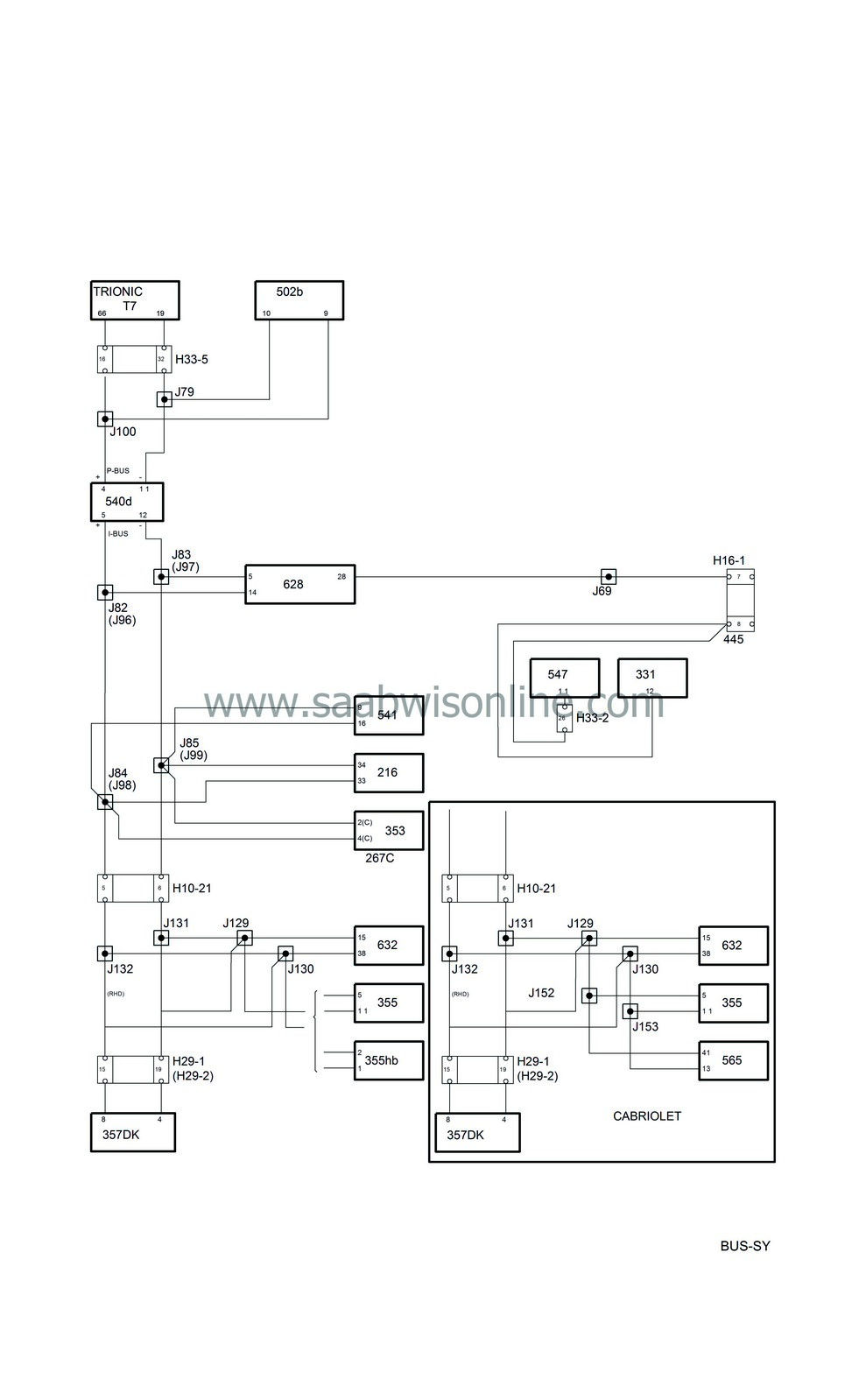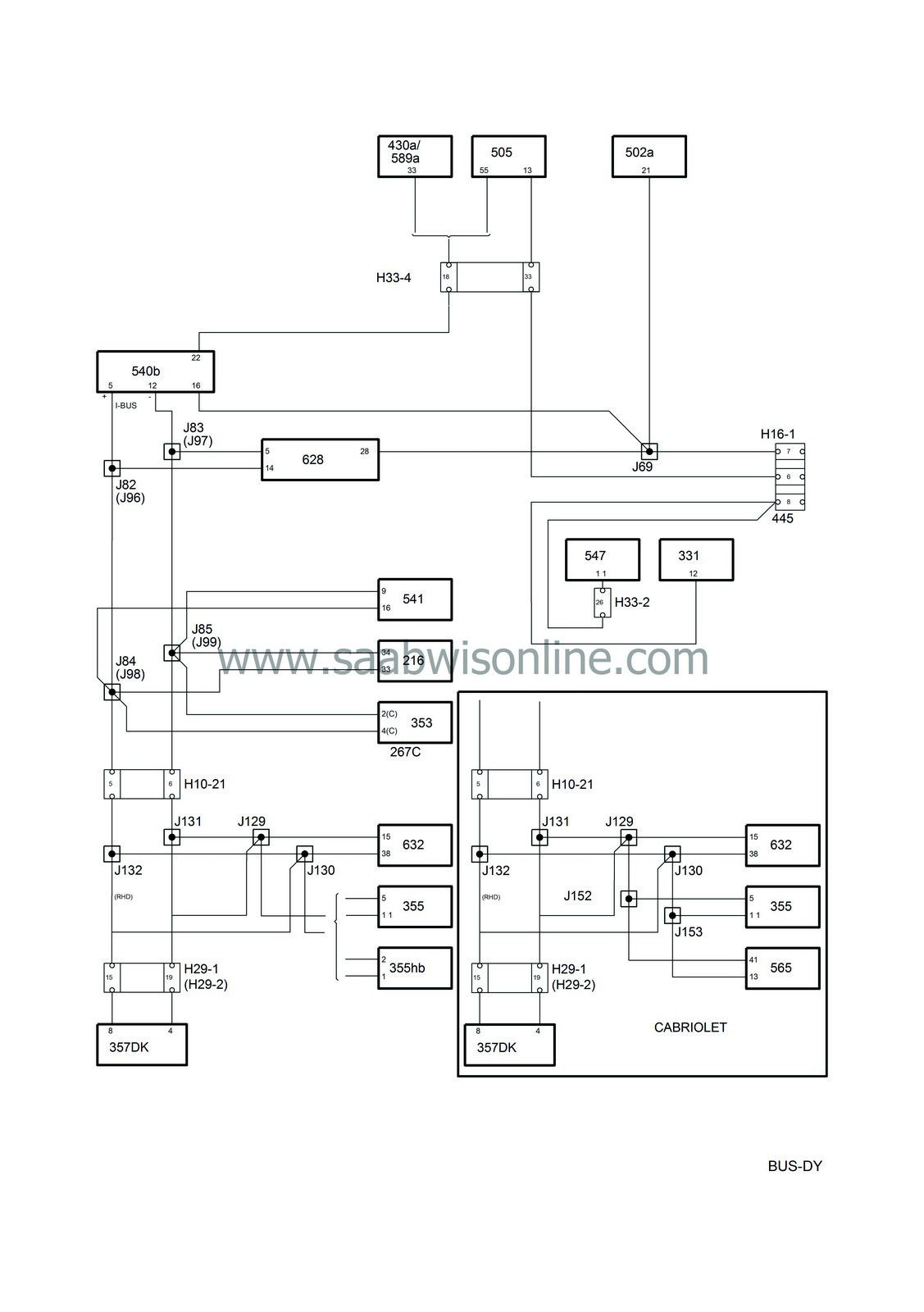Bus communication
| Bus communication |

| • |
ACC control module (216)
|
|
| • |
Radio connector C (267c)
|
|
| • |
Airbag/SRS control module (331)
|
|
| • |
Radio (353)
|
|
| • |
CD changer (355)
|
|
| • |
PSM control module (357Dk)
|
|
| • |
Trionic control module (430)
|
|
| • |
Control module, TCM (502)
|
|
| • |
Control module M2.10.3 (505)
|
|
| • |
MIU (540)
|
|
| • |
SID (541)
|
|
| • |
Control module (ABS) 547
|
|
| • |
STC control module (565)
|
|
| • |
Trionic OBDII control module (589)
|
|
| • |
Auxiliary heater control module (597)
|
|
| • |
DICE control module (628)
|
|
| • |
TWICE control module (632)
|
|
| P bus and I bus |
A bus is understood to be the leads over which information is sent digitally and serially. Digital means that the voltage difference between the leads has only two values, roughly 0 V and 5 V. The information is coded so that different combinations of 0 V and 5 V have different meanings.
Serial means that the information is sent in ”packets” which are transmitted one after the other in rapid succession.
Half of the control modules in the Saab 9-3 are connected to the bus. On generation IV engines (B205L/R, B235R), TCM is connected to the P-bus, see below. On other engines (generation III), TCM is not connected to a bus.
The buses consist of a P bus (Powertrain Bus) and an I bus (Instrument Bus). Both buses are connected to the MIU (Main Instrument Unit). The buses are electrically isolated from each other.
The diagnostic tool is not connected directly to the bus but communicates via the DICE, one of the control modules connected to the I bus, and so has access to all control modules connected to the bus.
The data transfer rate of the P bus is ten times faster than that of the I bus. The reason for this is that the powertrain systems need information with the least possible delay.
All the information sent out from a control module is available to all other bus-connected control modules. The MIU sees to it that information which is available on one bus is also available on the other bus.
The control modules send out information on the bus at regular intervals. The time between two transmissions depends on what information is being transmitted and varies between 10 milliseconds (0.010 seconds) and 1 second. Information is also transmitted by the control module whenever the information changes.
The transfer of information between the control modules takes place on two leads, bus+ (green lead) and bus- (white lead). The two leads are twisted to reduce sensitivity to electrical interference.
| Diagnostics |
In a bus system, it is essential that all the units can communicate with each other. For example, the engine can not be started unless Trionic can receive immobilizer information sent from TWICE.
| Permanent bus faults |
All Tech2–communication with bus systems is via DICE. Irrespective of which system is being contacted, Tech 2 will first use DICE to make sure that all bus systems in the car are powered and are communicating. Tech 2 will indicate any bus control modules that are absent. This means that all the bus control modules are communicating unless Tech 2 warns otherwise.
| Intermittent bus faults |
Trionic and TCM continuously check that all the control modules they receive information from are communicating correctly. In case of intermittent faults in bus communication, diagnostic trouble codes will be generated in Trionic and TCM. The cause of the fault can be that the control module in question has lost its power supply or one of the bus leads.
| Incorrect bus values |
Diagnostic trouble codes are generated in Trionic and TCM if any information they are retrieving has the incorrect value. The diagnostic trouble code text indicates the system that is at fault. For further information concerning the bus, see Bus and diagnostic communication.
| TCM uses the following information |
|
Information
|
Unit
|
Sensor system
|
Description
|
|
Engine torque
|
Nm
|
Trionic
|
Current air mass/combustion is converted to engine torque, unit Nm
|
|
Pedal position
|
%
|
Trionic
|
Highest requested value of air mass/combustion from the pedal position or cruise control is selected. The value is converted to a corresponding pedal position, unit %.
|
|
Engine speed
|
rpm
|
Trionic
|
Current engine speed, unit rpm. The value is also used to compare engine speed to gearbox input speed when Lock-Up is engaged. If the difference is greater than 100 rpm between the engine speed and the gearbox input speed, diagnostic trouble code P0741 will be generated.
|
|
Brake lights
|
ON/OFF
|
TWICE
|
Brake lights, unit ON/OFF.
|
| TCM sends the following information: |
|
Information
|
Unit
|
Used by
|
Description
|
|
Maximum permissible engine torque
|
Nm
|
Trionic
|
TCM sends maximum permissible engine torque, unit Nm. The value is used for engine torque limitation in the air mass control system.
|
|
SPORT
|
ON/OFF
|
Trionic, MIU
|
TCM sends sport mode, unit ON/OFF. The value is used in air mass control to correct the pedal position conversion to requested air mass/combustion. MIU turns on the SPORT indicator lamp.
|
|
Selector lever position
|
P, R, N, D, 3, 2, 1
|
Trionic, MIU
|
TCM sends selector lever position, unit P, R, N, D, 3, 2 and 1. Trionic uses the value in air mass control for idle speed control. MIU uses the value to turn on the relevant segment in the selector lever display.
|
|
CHECK GEARBOX Lamp
|
ON/OFF
|
MIU
|
When the on-board diagnosis reports that the lamp is to be turned on, ON, unit ON/OFF is sent. The value is used by MIU.
|
|
WINTER lamp
|
ON/OFF
|
MIU
|
When the WINTER mode is selected, WINTER ON, unit ON/OFF is sent. MIU turns on the WINTER indicator lamp.
|
|
Text message HIGH GEARBOX FLUID TEMPERATURE
|
Text message
|
SID
|
When the gearbox fluid temperature exceeds 170°C, HIGH GEARBOX FLUID TEMPERATURE, unit ON/OFF is sent. SID displays this message.
|



